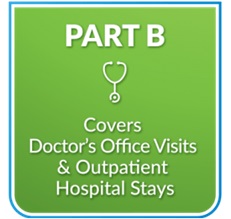When You Become Eligible
Medicare may automatically enroll you in Original Medicare, if you are already receiving Social Security benefits. Original Medicare includes Parts A and B. See more information about parts A and B.


If you are not collecting Social Security and are not enrolled automatically, you can enroll in parts A and B by going to https://www.ssa.gov/benefits/medicare/, by calling a Social Security office at 1-800-772-1213, or by visiting a local Social Security office.
You are eligible for premium-free Part A if you are age 65 or older and you or your spouse worked and paid Medicare taxes for at least 10 years. You can get Part A at age 65 without having to pay premiums if:
Part A and B Start Dates: Coverage starts based on the month you sign up:
| If you sign up: | Coverage starts: |
|---|---|
| Before the month you turn 65 | The month you turn 65 |
| The month you turn 65 | The next month |
| 1 month after you turn 65 | 2 months after you sign up |
| 2 or 3 months after you turn 65 | 3 months after you sign up |
While most people do not have to pay a premium for Part A, everyone must pay for Part B if they want it. This monthly premium is deducted from your Social Security, Railroad Retirement, or Civil Service Retirement check.
If you do not get any of these payments, Medicare sends you a bill for your Part B premium every 3 months. However, you can fill out a form to have the part B premium come out of your bank account.
Once you start collecting Social Security it will automatically start being deducted from your check.
Your premium for part B may be higher than the standard if your income is higher. Most people will pay the standard premium amount. If your modified adjusted gross income is above a certain amount, you may pay an Income Related Monthly Adjustment Amount (IRMAA).
Medicare uses the modified adjusted gross income reported on your IRS tax return from 2 years ago. This is the most recent tax return information provided to Social Security by the IRS. The chart below lists the extra amount costs by income.
If your yearly income in 2023 (for what you pay in 2025) was
| File individual tax return | File joint tax return | File married & separate tax returns | You pay each month (in 2025) |
|---|---|---|---|
| Less than or equal to $106,000 | Less than or equal to $212,000 | Less than or equal 103,000 | $180.00 |
| $106,000 to $133,000 | $212,000 to $265,000 | Not applicable | $251.90 |
| $133,000 to $166,000 | $265,000 to $332,000 | Not applicable | $359.90 |
| $166,000 to $199,000 | $332,000 to $398,000 | Not applicable | $467.80 |
| #199,000 to $500,000 | $398,000 to $750,000 | $103,000 to 397,000 | $576.00 |
| Greater than $500,000 | Greater than $750,000 | Greater than $397,000 | $612.00 |

If You Have a Higher Income
You may also pay more for your Part D premium. If your income is above a certain limit ($91,000 if you file individually or $182,000 if you’re married and file jointly), you’ll pay an extra amount in addition to your plan premium (sometimes called “Part D-IRMAA”). You’ll also have to pay this extra amount if you’re in a Medicare Advantage Plan that includes drug coverage. This doesn’t affect everyone, so most people won’t have to pay an extra amount. The chart below lists the extra amount costs by income.
If your filing status and yearly income in 2023 was
| File individual tax return | File joint tax return | File married & separate tax returns | You pay each month (in 2025) |
|---|---|---|---|
| Less than or equal to $106,000 | Less than or equal to $212,000 | Less than or equal to $103,000 | your plan premium |
| $106,000 to $133,000 | $212,000 to $265,000 | Not applicable | $13.30 + your plan premium |
| $133,000 to $166,000 | $265,000 to $332,000 | Not applicable | $34.30 + your plan premium |
| $166,000 to $199,000 | $332,000 to $398,000 | Not applicable | $55.40 + your plan premium |
| $199,000 to $500,000 | $398,000 to $750,000 | $103,000 to $397,000 | $76.50 + your plan premium |
| Greater than $500,000 | Greater than $750,000 | Greater than $750,000 | $83.50 + your plan premium |
Part B Late Enrollment Penalty
If you didn't get Part B when you were first eligible, your monthly premium may go up 10% for each 12-month period you could've had Part B, but didn't sign up. In most cases, you'll have to pay this penalty each time you pay your premiums, for as long as you have Part B. And, the penalty increases the longer you go without Part B coverage.
Usually, you don't pay a late enrollment penalty if you meet certain conditions that allow you to sign up for Part B during a Special Enrollment Period.



